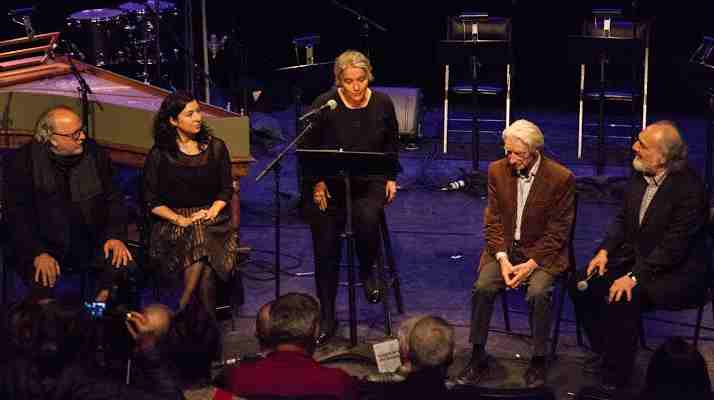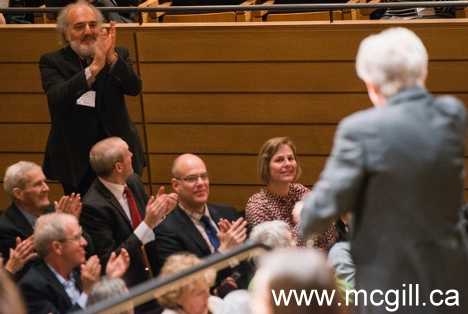SOCIETE DE MUSIQUE CONTEMPORAINE
DU QUEBEC

music reviews by
NANCY SNIPPER
______________________________________________________________
2016
AN EVENING
OF MERGING AND MORPHING ANCIENT MUSIC INTO THE CONTEMPORARY
Performance
at Usine C, May
16th, .2016
SMCQ
presented a dissonant but interesting multi-media sound and visual
event of tragic overtones in the main work featured. Titled, "Le
Petit Livret des Ravalets,” what we witnessed was inspired
by a true shameful story. Originally written in the 19th century
by French novelist Barbey d’Aurevilly (1808-89), the subject
matter was daringly exposed. In the 20th century, the event was
turned into theatrical  work
by Mignolet Brochocka. Its third reincarnation we saw with SMCQ,
a sparse opera of sorts where ancient instruments and a completely
modern score utilized two singers, two readers and a narrator
and a projection of two lovers moving in slow motion to recreate
this love story of incest: two nobles – a brother and sister
broke the taboo of love and eventually were hung for their wrong
deed.
work
by Mignolet Brochocka. Its third reincarnation we saw with SMCQ,
a sparse opera of sorts where ancient instruments and a completely
modern score utilized two singers, two readers and a narrator
and a projection of two lovers moving in slow motion to recreate
this love story of incest: two nobles – a brother and sister
broke the taboo of love and eventually were hung for their wrong
deed.
Modernized
in music (John Rea wrote this opera in 1983) and text, Brochocka
cast his own moral views in the text while condemning the Inquisition
that was happening during the time of these doomed siblings. So
from the 16th-century all the way to the present, the story has
endured. I did not care for the story nor the opera, but Walter
Boudreau conducted a marvellously atonal and skittishly rhythmic
piece that required all kinds of ancient instruments and weird
ones, including a tubular swing in the air thing that resembled
'snake' floater for swimming. Suzie LeBlanc has a lovely soprano
voice, but Marie-Annick Béliveau who performed Harry Somer’s
piece “Twelve Miniatures”of Haiku poetry – offered
thin mezzo-soprano vocals. In fact, in this piece, she rarely
looked up from her music lectern; no eye contact was made with
us.
On the
contrary, Ms. LeBlanc who performed“Feygl Oyf Di Tsvaygn”
(2008), a moving Yiddish poem about death at the hands of the
Nazis was haunting, and she knew the music; whereas in the first
opening song, “Per Trop Talor se Perigola,” which
featured both singers with baroque recorder and harpsichord showed
the mezzo singer’s weakness. Composed in the 14-century
(Anonymous), it was lovely, but LeBlanc certainly shone over Béliveau.
More
on the program proved to me that turning old music into a modern
compositional remixing does not work. Then again, in the spirit
of full disclosure, I’m not a fan of taking a Shakespearian
play and modernizing it where set, costumes and accents have deviated
from the original.
BIG APPLE
JAM: CONTEMPORARY COMPOSITIONS DAZZLE WITH DYNAMIC DISSONANCE
SMCQ’s
concert in Pierre Péladeau’s Pierre-Mercure Theatre
on May 21st was an unabashed display of wildly brazen sounds that
stunningly reflect how cacophonous modern music dramatically impacts
on and excites the listener.
The program
featured five outstanding works of which the first three made
the last two (Ebony Concert) by Stravinsky and Bernstein
(Prelude, Fugue and Riffs) sound like tamed passé
pieces promoting more harmonic appeal despite daring moments of
razzle-dazzle big band sounds. Certainly Bernstein’s piece
held familiar melodies that sounded like they were lifted from
the score of West Side Story, and Stravinsky’s
interesting work had his iconic staccato 12-tone instrumental
interplay with bouncy ragtime parts and smooth moments of a slow
trudging melodic line. Contrast and lightness was most effective
in this work. But for the entire evening, it was Bernstein who
lit the fire with his dashing composition which was masterfully
conducted by SMCQ’s brilliant Walter Boudreau. He was honoured
post-concert by Quebec’s Conseil des arts et des letters).
Clarinettist, André Moisan was awesome on his instrument,
poignantly soaring in ways that would have delighted made Woody
Herman proud.
However,
it was Ballet mécanique – the opening piece
that held us in a shock-and-awe vice. Composed by the enfant terrible
– a name dubbed by Stravinsky himself and his contemporarily
pals, George Antheil composed an astoundingly innovative work
of epic proportions. At the piano wearing earphones was Guy Livingston
playing to 4-taped pianos and other instruments to create a chaotic
clash of percussive noisy music simultaneously sounding off to
an amazing assortment of images flashing on the projected back
wall screen. Akin to this hyper kinetic visual was a Dadaist post-Cubist
film called Ballet created by Fernand Léger and
Dudley Murphy. Akin to Fritz Lang’s 1927 film, Metropolis,
the hyper kinetic visuals of humans, geometric shapes, axels and
all kinds of activities were in complete sync with the music.
The piano playing was a staggering feat that demanded herculean
octaves, trilling, percussive punches  that
scaled up and down the piano – and all in super fast-speed
motion to match the film’s own flash of images.
that
scaled up and down the piano – and all in super fast-speed
motion to match the film’s own flash of images.
Star
of SMCQ -- along with Boudreau -- is the genius composer John
Rea. Two of his compositions were featured: Big Apple Jam was
a 4-saxophone sensation that conjured up all of New York’s
disparate vitality. The piece comprised 12 musicians adhering
to instrumental quartet grouping; so along with the saxes were
four clarinets and four strings. Gershwin’s "I Got
Rhythm" interceded a moment in the work – a composition
that certainly showcased the brilliance of the musicians and how
incredible their timing was and experience to produce that boisterous
big band sound.
In 1982,
Rea composed Treppenmusik. He revealed this work was
inspired by Escher, the artist and his legendary staircase drawings.
Rea likened the structure to spiral music as he was attempting
to morph the artist’s visual into sounds. I loved this piece,
as it offered images of running up and down staircases and feelings
of fatigue having to walk up them. The great amount of trilling
on the instruments conveyed repetitive ascending along with the
constant mundaneity of stairs and our interaction with them. In
fact a labyrinth of textures, rhythms and melodies within the
contemporary musical vein offered excitement and excited our imaginations.
Being
a lover of classical music, personally, I was surprised how much
I enjoyed the concert. The performance of these musicians and
their virtuoso attack made me realize just how difficult it is
to master all the syncopations, instant mood changes and techniques
contemporary music demands